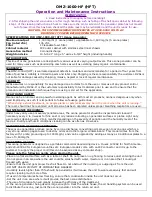
11
803161 Rev. 01
Built-in Operating Delay
An adjustable time delay is provided in the control
circuitry to manage the changeover from reverse cycle
heat to resistance heat, and is factory-set for 3.5
minutes. As a result, in some cases there will be a 3.5
minute delay for reverse cycle heat to initiate. This will
occur in the following situation:
When the unit is first plugged in, or if the unit has just
been switched to heating mode, reverse-cycle heat
(compressor operation) will be delayed for 3.5 minutes.
However, the unit will provide heat for the first 3.5
minutes via the resistance heater. Once the initial 3.5
minutes has elapsed, if there is still a call for heat from
the thermostat, and if the outdoor temperature is in heat
pump range, the compressor will start and cycle
normally on the room temperature thermostat within
the unit. No further time delays are incurred provided
the switch remains in the heating position.
There is no time delay in the cooling mode.
Indoor Coil Freeze Protection
Control of frost on the evaporator coil due to low
indoor loads, or cold outdoor ambient temperatures, is
provided.
Emergency Heat Switch (RSHPC Heat Pump Only)
If the compressor fails and there is heating demand,
heat pump units will have a rocker switch that can
switch the unit into electric resistance heat mode, until
a repair can be made. Located on the right bottom
corner of the control box is a rocker switch used to
switch between normal and emergency heat operation.
The front cover must be removed to access the switch.
Low Outdoor Temperature Lock-out
If the outdoor temperature is too low for proper
compressor operation, cooling operation will be
suspended, and also heat pump heating operation (if
applicable) will switch over to electric resistance
heating mode automatically if there is a demand for
heat, until the outdoor temperature rises to an
acceptable point, depending on the application.
Thermostat Temperature Limiting Feature
The purpose of temperature limiting is to allow the
property owner to control the maximum and minimum
temperature that an end-user can obtain during
operation of the unit, and can be an important energy
saving feature. This is accomplished by limiting the
thermostat knobs range of rotation between preset
limits set by the property owner. The unit is shipped
from the factory allowing a wide range of rotation.
Altering the range of rotation is easily done.
Remove the thermostat knob by pulling it with
sufficient force—DO NOT PRY. Turn the knob over
and observe the plastic rib coming off the side of the
knob stem. The rib is designed to engage limiting stop
screws that can be arranged to limit the maximum and
minimum set-point temperatures for the thermostat. On
the dial plate, just below the thermostat shaft you will
notice two Phillips head screws (with washers) in
“Standard Position” in the above illustration. This
allows a wide range of thermostat rotation,
representing a range of temperatures between
approximately 18°C and 29°C (65ºF and 85ºF). The
left screw in Standard Position can be removed and re-
inserted in four alternate holes moving in a clockwise
direction in order to reduce the maximum allowable
set-point temperature for heating. Similarly, the right
screw can be relocated in four alternate holes moving
in a counter-clockwise direction to increase the
minimum allowable set-point for cooling. Moving to
the next screw location alters the set point limit by
about 1.4ºC (2.5ºF), as shown in the illustration below.






























